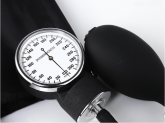Program Profile
Expanding the Scope of Telemedicine in Gastroenterology
A specialty outreach program relied on telemedicine to reach patients with gastrointestinal and liver diseases in a large service area.
Brandon Briggs is an Exercise Physiologist, Chani Jain is a Biostatistician, and Krisann Oursler is a Physician and the Director of Geriatric Research and Education at the Salem VAMC in Virginia. Miriam Morey is Associate Director of Research in the Geriatric Research, Education, and Clinical Center (GRECC) at Durham VAMC in North Carolina. Erin Blanchard is an Exercise Physiologist and Cathy Lee is a Physician in the GRECC at the Greater Los Angeles VAHS in California. Willy Marcos Valencia is a physician in the GRECC at the Miami VAHS in Florida. Dr. Morey is a Professor at Duke University Medical Center in Durham. Dr. Lee is an Associate Professor at the David Geffen School of Medicine at University of California Los Angeles. Dr. Valencia is an Assistant Professor at University of Miami Miller School of Medicine and Florida International University in Miami, Florida. Dr. Oursler is an Associate Professor at Virginia Tech Carilion School of Medicine in Roanoke, Virginia.
Correspondence: Krisann Oursler (krisann.oursler@va.gov)
Author disclosures
The authors report no actual or potential conflicts of interest with regard to this article.
Disclaimer
The opinions expressed herein are those of the authors and do not necessarily reflect those of Federal Practitioner, Frontline Medical Communications Inc., the US Government, or any of its agencies.
To participate in Gerofit, veterans must be able to perform activities of daily living and self-manage an exercise prescription developed by the exercise instructor based on physical performance testing. These physical performance tests include measures that are independent predictors of disability, loss of independent living, and death, as well as surrogate measures of exercise capacity (eg, strength, endurance, balance).14,15 A novel aspect of Gerofit is that the physical performance assessment is used not only to determine physical limitations, but also to individualize the exercise prescription based on the observed deficits in strength, endurance, or balance. These assessments are performed at initial enrollment; 3 months, 6 months, and 1 year later; and annually after that. Currently, the center-based Gerofit programs administer 5 items of the Senior Fitness Test: 6-minute walk, 10-meter walk (10-MWT), 30-second 1-arm curl, 30-second chair-stand test, and 8-foot up-and-go.15 The side-by-side, semitandem, and tandem standing balance tests from the short physical performance battery also are performed.16 In addition, participants complete a questionnaire that includes items from the physical functioning scale of the 12-Item Short Form Health Survey (SF-12).
After each assessment, the Gerofit exercise instructor reviews the results with the veteran and formulates an individualized exercise prescription along with goals for improvement. Veterans are encouraged to attend supervised center-based exercise sessions 3 times weekly. Classes are offered in a gym or fitness center at the VAMC or in leased space. Each patient uses a cue card that lists an exercise plan personalized for intensity and duration for aerobic exercise (AEX; eg, treadmill walking, stationary bicycling, arm ergometry), RT using dumbbells and weight equipment, and functional exercises for flexibility and balance. Some medical centers also offer yoga, tai chi, or dancing Gerofit classes.
For participants in the Durham Gerofit program, mortality decreased 25% over a decade (hazard ratio, 0.75; 95% CI, 0.61-0.91).9 A substudy that included the Psychological General Well-Being Index found that 81% of participants significantly increased their score after 1 year.7 Observed initial improvement in physical performance has been sustained over 5 years.10,17 One-year results from the recent Gerofit expansion to 6 other VAMCs showed clinically and statistically significantly improved physical performance from baseline to 3-, 6-, and 12-month follow-up.18
Initial work. The Greater Los Angeles VAMC Gerofit program conducted a pilot CVT exercise class of 6 veterans at the rural Bakersfield CBOC in California.19 Each week, an exercise instructor broadcast a 60-minute exercise class that included warm-up, RT with bands, progressive balance training, and flexibility. Trained student volunteers from California State University in Bakersfield kinesiology program were on site at the Bakersfield CBOC to perform the assessments and aid in exercises during the CVT sessions. Despite the lack of AEX per se, veterans showed significant improvement in endurance as measured by an increase in the number of steps completed in 2 minutes at the 3-month assessment (P = .049). Although exercises were not delivered in a circuit format, the improved endurance supported the potential for cardiovascular benefit from RT in older adults.
A specialty outreach program relied on telemedicine to reach patients with gastrointestinal and liver diseases in a large service area.

The present study demonstrated that standardized measurements of blood pressure were lower than the routine method used in most office settings....
